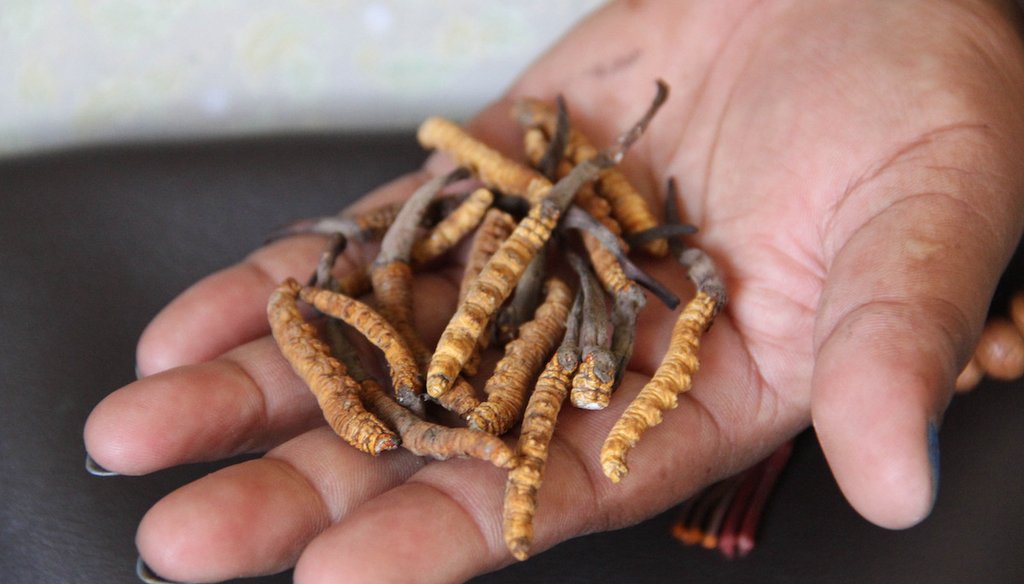

Our only agenda is to publish the truth so you can be an informed participant in democracy.
We need your help.


A Nepali woman holds caterpillars infected by Ophiocordyceps sinensis, or caterpillar fungus. (Shutterstock)
A Facebook post is claiming that a fungus found in the Himalayas contains a highly potent, cancer-killing compound.
The Jan. 26 post includes a picture of the fungus with text underneath it that reads "Cancer killed!"
"A molecule found in a Himalayan fungus could be the breakthrough for cancer patients," the post goes on to say. "This molecule kills cancer cells with 40 times the potency."
The post was flagged as part of Facebook’s efforts to combat false news and misinformation on its News Feed. (Read more about our partnership with Facebook.)
The post depicts a fungus that is used in natural medicine to treat cancer and other illnesses, and that researchers are studying for its cancer-killing potential. But its claim about potency against cancer cells incorrectly equates a molecule found in that fungus with a drug derived from the molecule.
Although the post doesn’t mention the fungus by name, we ran a Google reverse image search and found that the photo showed a fungus called Ophiocordyceps sinensis, or the caterpillar fungus.
Only found 10,000 feet above sea level in the Tibetan Plateau and Himalayas, the fungus acts as a parasite by infecting the larvae of ghost moths and sprouting from the head of the dead insect, according to Insider.
Because it’s located in a remote region and is harvested by hand, the fungus is rare, and a single gram of it can cost from $30 to $125, Insider reported. That’s as much as $3,500 an ounce.
Demand for the fungus has risen over the years, as it’s used often in traditional Asian medicine for its supposed immunity boosting power. The fungus has been used to treat a variety of maladies, including cancer, according to The Atlantic.
It’s also used often as an aphrodisiac, and has been called the "Himalayan Viagra."
The post claims a molecule in the fungus can kill cancer cells with "40 times the potency." It doesn’t provide much context for the potency claim or explain what it’s comparing the molecule to. There is a basis for that number, but the post describes it incorrectly.
Researchers at the University of Oxford announced in October that they were working with the United Kingdom drug company NuCana to develop a chemotherapy drug derived from the fungus.
Researchers found the fungus contained a natural nucleoside analogue, a type of antiviral compound used in therapeutic drugs, which has cancer-killing properties. But the compound breaks down in the blood quickly, and only a small amount of it is ever delivered to a tumor, researchers said.
NuCana was able to design a drug derived from the compound that researchers said was longer-lasting and had a "40 times greater potency for killing cancer cells" than what’s found naturally in the fungus, the University of Oxford reported.
Testing of the drug’s cancer-killing power has primarily been in a laboratory setting, but preliminary results from Phase I clinical trials have shown "encouraging signals of anti-cancer activity" in people who have received it, according to an article published by the researchers.
Phase II trials are underway and involve testing the drug's possible impact on solid tumors and lymphoma. The trial is expected to be completed by July.
Despite its use in traditional medicine as a cancer treatment and the research into its antiviral properties, the National Cancer Institute said the fungus is currently "not an approved treatment for any type of cancer."
Since the drug is still in the early clinical trial phase, and its potency was only measured in a laboratory setting, it's still far away from being a breakthrough in cancer treatment as suggested in the Facebook post.
A Facebook post claims a molecule found in a Himalayan fungus can kill cancer with "40 times the potency."
The fungus, known as Ophiocordyceps sinensis, has been used in traditional Asian medicine to treat a variety of illnesses including cancer.
Researchers in the United Kingdom have found that the fungus contains an antiviral compound that has anti-cancer effects. They were able to derive a chemotherapy drug from the compound, and laboratory tests showed it was 40 times more potent in destroying cancer cells than what’s found naturally in the fungus.
It is the drug that’s derived from the compound in the fungus — not the compound in the fungus itself — that has the potent cancer-killing power. We rate this claim Half True.
Facebook post, Jan. 26, 2022
Archive of Facebook post, Jan. 27, 2022
Insider, "Caterpillar fungus, the world's most valuable parasite, can cost up to $63,000 per pound," June 14, 2021
The Atlantic, "The World’s Most Valuable Parasite Is in Trouble," Oct. 22, 2018
The New York Times, "Demand for ‘Himalayan Viagra’ Fungus Heats Up, Maybe Too Much," June 26, 2016
University of Oxford, "Anti-cancer drug derived from fungus shows promise in clinical trials," Oct. 8, 2021
National Library of Medicine, Nucleoside Analogues, accessed Feb. 14, 2022
Clinical Cancer Research, "The Novel Nucleoside Analogue ProTide NUC-7738 Overcomes Cancer Resistance Mechanisms In Vitro and in a First-In-Human Phase I Clinical Trial," Dec. 1, 2021
ClinicalTrials.gov, "A Safety, Pharmacokinetic and Clinical Activity Study of NUC-7738 in Patients With Advanced Solid Tumours and Lymphoma," Jan. 28, 2022
Email with the National Cancer Institute, Feb. 1, 2022
In a world of wild talk and fake news, help us stand up for the facts.
